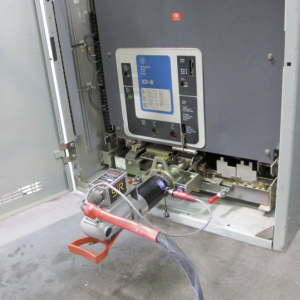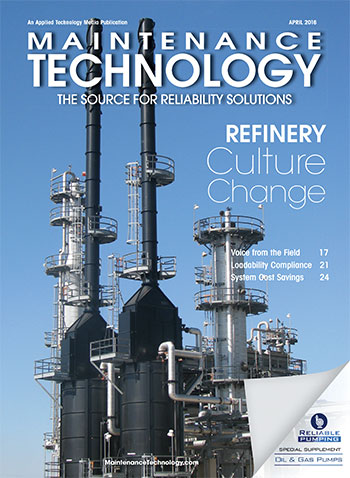By Tim Burttram, Plant Electrical Engineer, Cascade Steel
With the threat of an arc flash incident at circuit breakers, distance can be an operator’s best friend. That’s one of the facts that led Cascade Steel to evaluate the latest offerings in remote circuit-breaker racking technology. The mill wanted a remote racking system that was quick and easy to deploy. Wasting money on a piece of equipment that electricians and maintenance personnel wouldn’t use wasn’t feasible.

Founded in 1968, Cascade Steel Rolling Mills is a state-of-the-art steel-manufacturing facility that takes recycled metal and turns it into high quality finished steel products. Located in McMinnville, OR, the company’s electric arc furnace (EAF) mini-mill produces a wide range of hot-rolled products such as reinforcing bar (rebar), coiled reinforcing bar, wire rod, merchant bar and other specialty products.
Like other industrial operations, Cascade Steel is tasked with safeguarding its workers, equipment assets and the environment. Any company that generates, transmits, distributes, or uses electricity at high, medium or even low voltages has an obligation to protect its personnel from hazards such as arc flash that might occur in switchgear equipment.
Breaker racking Issues
Arc flash hazard mitigation is at the top of every plant or mill’s electrical-system-safety list. Employers must ensure that their electrical-system workers go home at night by understanding arc flash risks and the latest technologies designed to minimize them.
The simple act of manually racking a circuit breaker, with an operator positioned in front of the device, creates an arc flash hazard. Parts break or don’t line up. Equipment malfunctions. Even with the best personal protective equipment (PPE) made, plant and mill workers are still going to get hurt in some way if things go badly.
At the Cascade Steel site, plant personnel recognize the NFPA70E standard as the basis for their electrical safety program. To work on electrical apparatus with elevated energy levels, electricians must de-energize upstream equipment to avoid the potential for an arc flash. This means opening and closing circuit breakers, and eliminating power to various areas of the melt shop or rolling mill— a potentially dangerous situation for both human and equipment assets.
History has shown there is no better protection against a potentially deadly arc flash incident than a safe working distance between the operator and the switchgear. This approach has clear advantages over flash suits designed only to decrease exposure to burns, and also minimizes the risks posed by airborne projectiles often associated with arc blast fatalities.
To reduce hazards to employees, many mill sites are installing remote circuit- breaker racking systems that allow operators to safely rack breakers from a remote location. Remote racking systems offer a safe alternative to manually racking circuit breakers and reduce the requirement for service personnel to wear a full-body arc flash hazard suit for protection: Designed to remove operators from close proximity to the breaker that’s being racked, these system permit the insertion and removal of electrical devices while the operator is outside the flash-protection boundary.
Following its evaluation of remote racking options, Cascade Steel chose the Safe-T-Rack system from Remote Solutions LLC. This system places a protective barrier of up to 150 feet between the operator and the energized breaker. It also differs substantially from common “land-based” systems that must either be moved to the breaker location on a cart or affixed to a large base with a motor-driven mast.
Some users find land-based racking systems cumbersome: They can weigh hundreds of pounds and aren’t very portable. With this type of system, the operator must properly finesse the device to the face of the work on the circuit breaker compartment, register the X/Y/Z coordinates relative to the racking points and then secure the tool. This procedure can take up to 20 minutes per breaker-and also introduces human-performance concerns. Tool alignment problems can result in physical damage to the circuit breaker, rendering it un-serviceable.
Conversely, the remote racking device that Cascade Steel chose is easily operated with switchgear elevated off of the ground and includes fail-safe mechanisms to keep personnel from misapplying it to the wrong breaker. It also includes specific attachments and software to address particular racking parameters such as torque and breaker travel. The switchgear-based racking apparatus can be mounted on the breaker itself, or on the breaker-compartment door so it can be registered correctly to the racking points.
To date, Cascade Steel has installed remote racking apparatus on every rackable breaker in its mill-regardless of voltage level. The company is now working on getting remote racking for three additional 480-volt, molded-case SPB rackable breakers.
How the system works
With a switchgear-based tool alignment philosophy, the operator uses the switchgear as a reference, aligning the remote racking apparatus only once. The device includes the exact racking point coordinates for a given circuit breaker design, and is affixed to the breaker compartment door to allow all racking tool pieces to be easily loaded or mounted. The racking point coordinates are fixed so that any time a mill worker mounts dry brackets, for example, the center point for the tool is aligned for insertion directly at the racking screw.
“Human factor” engineering also establishes a “chain of rejection” to minimize human error. This enables technicians to consistently handle racking applications on multiple breakers of various configurations.
A touchscreen human-machine Interface (HMI) for “closed-door” racking also benefits mill operators. Redundant digital drives with battery backup provide fail-safe racking in the event of a power failure. Real-time breaker travel indication and user controls include an emergency stop at any time during racking, manual start/stop, and automatic retrieval and recovery of a circuit breaker.
A torque limiter for different manufacturers’ breakers found throughout the mill counts the number of turns as well as displaying real-time travel position. The system stimulates all OEM breaker interlock systems and automatically operates and monitors positive interlock.
In addition, tilt-angle monitoring allows operators to track the pitch and roll of a breaker during racking to minimize potential equipment damage. Should the device detect an out-of-level situation, it will stop the racking process. Over-torque protection is also provided for the racking motor should the shutters not open, or if the breaker becomes bound in the racking process. This consistent process will extend the life of switchgear.
Some plants and mills make a big investment in a cart-based remote circuit- breaker racking system, only to find it goes unused. This means the facility has wasted its money and not accomplished its objective of getting workers out of the danger zone.
With a switchgear-based remote racking system, sites gain a safe, reliable and user-friendly alternative to manually racking breakers, which reduces the requirement for operators to wear a full-body arc flash hazard suit for protection. They can rack a breaker properly by its original design and insert and remove the equipment while remaining outside the flash-protection boundary.
 By Rick Carter, Executive Editor
By Rick Carter, Executive Editor


 We are all familiar with potential hazards relating to arc flash and other electrical incidents. But what about other safety issues that plants and facilities face? Some common, yet often overlooked, safety issues include those relating to pressure and pressurized systems. These include boilers and their associated distribution systems and high-pressure refrigerants. While this is not a complete list, it’s worth noting that incidents involving these types of systems and products are just as important and potentially hazardous as any arc flash incident.
We are all familiar with potential hazards relating to arc flash and other electrical incidents. But what about other safety issues that plants and facilities face? Some common, yet often overlooked, safety issues include those relating to pressure and pressurized systems. These include boilers and their associated distribution systems and high-pressure refrigerants. While this is not a complete list, it’s worth noting that incidents involving these types of systems and products are just as important and potentially hazardous as any arc flash incident.